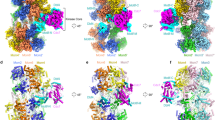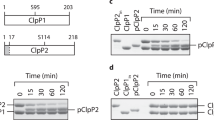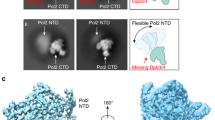Abstract
The removal of the mRNA 5′ cap (decapping) by Dcp2 shuts down translation and commits mRNA to full degradation. Dcp2 activity is enhanced by activator proteins such as Dcp1 and Edc1. However, owing to conformational flexibility, the active conformation of Dcp2 and the mechanism of decapping activation have remained unknown. Here, we report a 1.6-Å-resolution crystal structure of the Schizosaccharomyces pombe Dcp2–Dcp1 heterodimer in an unprecedented conformation that is tied together by an intrinsically disordered peptide from Edc1. In this ternary complex, an unforeseen rotation of the Dcp2 catalytic domain allows residues from both Dcp2 and Dcp1 to cooperate in RNA binding, thus explaining decapping activation by increased substrate affinity. The architecture of the Dcp2–Dcp1–Edc1 complex provides a rationale for the conservation of a sequence motif in Edc1 that is also present in unrelated decapping activators, thus indicating that the presently described mechanism of decapping activation is evolutionarily conserved.
This is a preview of subscription content, access via your institution
Access options
Subscribe to this journal
Receive 12 print issues and online access
$189.00 per year
only $15.75 per issue
Buy this article
- Purchase on Springer Link
- Instant access to full article PDF
Prices may be subject to local taxes which are calculated during checkout



Similar content being viewed by others
References
Arribas-Layton, M., Wu, D., Lykke-Andersen, J. & Song, H. Structural and functional control of the eukaryotic mRNA decapping machinery. Biochim. Biophys. Acta 1829, 580–589 (2013).
Jonas, S. & Izaurralde, E. The role of disordered protein regions in the assembly of decapping complexes and RNP granules. Genes Dev. 27, 2628–2641 (2013).
Lykke-Andersen, J. Identification of a human decapping complex associated with hUpf proteins in nonsense-mediated decay. Mol. Cell. Biol. 22, 8114–8121 (2002).
van Dijk, E. et al. Human Dcp2: a catalytically active mRNA decapping enzyme located in specific cytoplasmic structures. EMBO J. 21, 6915–6924 (2002).
Wang, Z., Jiao, X., Carr-Schmid, A. & Kiledjian, M. The hDcp2 protein is a mammalian mRNA decapping enzyme. Proc. Natl. Acad. Sci. USA 99, 12663–12668 (2002).
She, M. et al. Structural basis of dcp2 recognition and activation by dcp1. Mol. Cell 29, 337–349 (2008).
She, M. et al. Crystal structure and functional analysis of Dcp2p from Schizosaccharomyces pombe . Nat. Struct. Mol. Biol. 13, 63–70 (2006).
Deshmukh, M.V. et al. mRNA decapping is promoted by an RNA-binding channel in Dcp2. Mol. Cell 29, 324–336 (2008).
Floor, S.N., Jones, B.N. & Gross, J.D. Control of mRNA decapping by Dcp2: an open and shut case? RNA Biol. 5, 189–192 (2008).
Floor, S.N., Jones, B.N., Hernandez, G.A. & Gross, J.D. A split active site couples cap recognition by Dcp2 to activation. Nat. Struct. Mol. Biol. 17, 1096–1101 (2010).
Floor, S.N., Borja, M.S. & Gross, J.D. Interdomain dynamics and coactivation of the mRNA decapping enzyme Dcp2 are mediated by a gatekeeper tryptophan. Proc. Natl. Acad. Sci. USA 109, 2872–2877 (2012).
Aglietti, R.A., Floor, S.N., McClendon, C.L., Jacobson, M.P. & Gross, J.D. Active site conformational dynamics are coupled to catalysis in the mRNA decapping enzyme Dcp2. Structure 21, 1571–1580 (2013).
Steiger, M., Carr-Schmid, A., Schwartz, D.C., Kiledjian, M. & Parker, R. Analysis of recombinant yeast decapping enzyme. RNA 9, 231–238 (2003).
She, M. et al. Crystal structure of Dcp1p and its functional implications in mRNA decapping. Nat. Struct. Mol. Biol. 11, 249–256 (2004).
Dunckley, T., Tucker, M. & Parker, R. Two related proteins, Edc1p and Edc2p, stimulate mRNA decapping in Saccharomyces cerevisiae . Genetics 157, 27–37 (2001).
Schwartz, D., Decker, C.J. & Parker, R. The enhancer of decapping proteins, Edc1p and Edc2p, bind RNA and stimulate the activity of the decapping enzyme. RNA 9, 239–251 (2003).
Borja, M.S., Piotukh, K., Freund, C. & Gross, J.D. Dcp1 links coactivators of mRNA decapping to Dcp2 by proline recognition. RNA 17, 278–290 (2011).
Lai, T. et al. Structural basis of the PNRC2-mediated link between mRNA surveillance and decapping. Structure 20, 2025–2037 (2012).
Fromm, S.A. et al. The structural basis of Edc3- and Scd6-mediated activation of the Dcp1:Dcp2 mRNA decapping complex. EMBO J. 31, 279–290 (2012).
Braun, J.E. et al. A direct interaction between DCP1 and XRN1 couples mRNA decapping to 5′ exonucleolytic degradation. Nat. Struct. Mol. Biol. 19, 1324–1331 (2012).
Tharun, S. & Parker, R. Analysis of mutations in the yeast mRNA decapping enzyme. Genetics 151, 1273–1285 (1999).
Chang, C.T., Bercovich, N., Loh, B., Jonas, S. & Izaurralde, E. The activation of the decapping enzyme DCP2 by DCP1 occurs on the EDC4 scaffold and involves a conserved loop in DCP1. Nucleic Acids Res. 42, 5217–5233 (2014).
Oldfield, C.J. & Dunker, A.K. Intrinsically disordered proteins and intrinsically disordered protein regions. Annu. Rev. Biochem. 83, 553–584 (2014).
Diebold, M.L., Fribourg, S., Koch, M., Metzger, T. & Romier, C. Deciphering correct strategies for multiprotein complex assembly by co-expression: application to complexes as large as the histone octamer. J. Struct. Biol. 175, 178–188 (2011).
Cheng, Y. & Patel, D.J. An efficient system for small protein expression and refolding. Biochem. Biophys. Res. Commun. 317, 401–405 (2004).
Kabsch, W. XDS. Acta Crystallogr. D Biol. Crystallogr. 66, 125–132 (2010).
Evans, P.R. An introduction to data reduction: space-group determination, scaling and intensity statistics. Acta Crystallogr. D Biol. Crystallogr. 67, 282–292 (2011).
Evans, P.R. & Murshudov, G.N. How good are my data and what is the resolution? Acta Crystallogr. D Biol. Crystallogr. 69, 1204–1214 (2013).
Winn, M.D. et al. Overview of the CCP4 suite and current developments. Acta Crystallogr. D Biol. Crystallogr. 67, 235–242 (2011).
McCoy, A.J. et al. Phaser crystallographic software. J. Appl. Crystallogr. 40, 658–674 (2007).
Murshudov, G.N. et al. REFMAC5 for the refinement of macromolecular crystal structures. Acta Crystallogr. D Biol. Crystallogr. 67, 355–367 (2011).
Emsley, P., Lohkamp, B., Scott, W.G. & Cowtan, K. Features and development of Coot. Acta Crystallogr. D Biol. Crystallogr. 66, 486–501 (2010).
Afonine, P.V. et al. Towards automated crystallographic structure refinement with phenix.refine. Acta Crystallogr. D Biol. Crystallogr. 68, 352–367 (2012).
Winn, M.D., Isupov, M.N. & Murshudov, G.N. Use of TLS parameters to model anisotropic displacements in macromolecular refinement. Acta Crystallogr. D Biol. Crystallogr. 57, 122–133 (2001).
Chen, V.B. et al. MolProbity: all-atom structure validation for macromolecular crystallography. Acta Crystallogr. D Biol. Crystallogr. 66, 12–21 (2010).
Adams, P.D. et al. PHENIX: a comprehensive Python-based system for macromolecular structure solution. Acta Crystallogr. D Biol. Crystallogr. 66, 213–221 (2010).
Zwart, P.H., Grosse-Kunstleve, R.W., Lebedev, A.A., Murshudov, G.N. & Adams, P.D. Surprises and pitfalls arising from (pseudo)symmetry. Acta Crystallogr. D Biol. Crystallogr. 64, 99–107 (2008).
Langer, G., Cohen, S.X., Lamzin, V.S. & Perrakis, A. Automated macromolecular model building for X-ray crystallography using ARP/wARP version 7. Nat. Protoc. 3, 1171–1179 (2008).
Smart, O.S. et al. Exploiting structure similarity in refinement: automated NCS and target-structure restraints in BUSTER. Acta Crystallogr. D Biol. Crystallogr. 68, 368–380 (2012).
Baker, N.A., Sept, D., Joseph, S., Holst, M.J. & McCammon, J.A. Electrostatics of nanosystems: application to microtubules and the ribosome. Proc. Natl. Acad. Sci. USA 98, 10037–10041 (2001).
Mizoue, L.S. & Tellinghuisen, J. The role of backlash in the “first injection anomaly” in isothermal titration calorimetry. Anal. Biochem. 326, 125–127 (2004).
Petoukhov, M.V. et al. New developments in the ATSAS program package for small-angle scattering data analysis. J. Appl. Crystallogr. 45, 342–350 (2012).
Tria, G., Mertens, H.D., Kachala, M. & Svergun, D.I. Advanced ensemble modelling of flexible macromolecules using X-ray solution scattering. IUCrJ 2, 207–217 (2015).
Acknowledgements
This work was supported by the Max Planck Society. We thank R. Büttner for excellent technical assistance with crystallization experiments, D. Peter for help with the ITC experiments and J.-M. Schmidt and H. Bhatt for experiments at the initial stage of the project. We thank the staff at the PX beamlines of the Swiss Light Source, Villigen, for assistance with data collection. We thank R. Rambo and N. Cowieson (Diamond Light Source, UK) for assistance with SAXS data collection at beamline B21of the Diamond Light Source, UK. The SAXS data collection was supported by funding (to E.V. and O.W.) from the European Community's Seventh Framework Programme (FP7/2007-2013) under BioStruct-X (grant agreement no. 283570).
Author information
Authors and Affiliations
Contributions
S.J. and E.I. conceived and designed the project. S.M. carried out protein purifications, pulldown assays and crystallographic work under the supervision of S.J. and E.V. E.V. solved the structures. S.J. performed initial experiments relating to the Dcp2–Dcp1 structure. E.V. and S.M. collected and analyzed the SAXS data. C.-T.C. performed decapping and RNA binding assays and analyzed data. S.M., E.V., S.J. and O.W. analyzed the crystallographic data. E.V., S.J., O.W. and E.I. wrote the manuscript with contributions from S.M. and C.-T.C. All authors discussed the results and commented on the manuscript.
Corresponding authors
Ethics declarations
Competing interests
The authors declare no competing financial interests.
Integrated supplementary information
Supplementary Figure 1 Domain architecture and conformational states of the decapping complex, as revealed by structural studies.
(a) Domain organization of Schizosaccharomyces pombe (Sp) and Saccharomyces cerevisiae (Sc) Dcp1, Dcp2 and Edc1 proteins. The numbers above the schematic represent amino acid positions at domain/motif boundaries. Dcp1 contains an Ena/Vasp homology domain1 (EVH1). The Sc Dcp1 EVH1 domain has an unstructured insertion (dotted line). The Dcp2 proteins have an N-terminal regulatory domain (NRD) and a catalytic Nudix domain. The Dcp2 C-terminus is highly divergent and interspersed with six helical leucine rich motifs (HLMs) in both Sc and Sp. The Edc1 proteins feature a conserved decapping activator motif (DAM) consisting of Dcp2-binding residues (DBR, comprising a YAGX2F motif) followed by a C-terminal proline-rich sequence (PRS) that binds to the Dcp1 EVH1 domain. (b) Cartoon representations of binary and ternary decapping complexes. The Dcp1 (green), Dcp2 N-terminal regulatory domain (NRD) (blue) and Dcp2 catalytic Nudix domain (cyan) adopt different relative orientations. The hinge region between the NRD and Nudix domains is shown in red. The β-strand extension and the HLM1 helix deleted in the Dcp2 construct used in this study are colored in black. The Box B helix of the Nudix domain is shown in purple. Conserved catalytic site residues in the Nudix domain are shown as purple sticks. The ATP co-crystallized with the closed conformation of the Dcp2–Dcp1 complex is shown as black sticks. The Edc1 DAM peptide is subdivided into a Dcp1-binding proline-rich sequence (PRS; magenta) and a Dcp2-binding residues (DBR; orange). (c) Sequence alignment of the DAM region of Edc1, Edc2 and PNRC proteins. Fully conserved residues are highlighted in dark orange, and those with >70% similarity are shown in light orange. Residues involved in Dcp1 and Dcp2 binding are indicated by green and blue triangles, respectively. Filled triangles mark residues contributing with their side-chain to the interface, and empty triangles signify pure backbone interactions. Species abbreviations are as follows: Schizosaccharomyces pombe (Sp), Saccharomyces cerevisiae (Sc), Arabidopsis thaliana (At), Ancylostoma ceylanicum (Ac), Nematostella vectensis (Nv), Anopheles gambiae (Ag), Danio rerio (Dr), Xenopus tropicalis (Xt), Gallus gallus (Gg), Homo sapiens (Hs).
Supplementary Figure 2 Structural superpositions.
(a) Structural superposition of the Dcp1–Edc1 complex (colored in gray; this study) onto the structure of the human DCP1 EVH1 domain bound to the PRS peptide from PNRC2 (green, salmon; PDB code 4B6H)18. The RMSD is 1.57 Å over 124 equivalent residues. (b) Structural superposition of the Dcp2–Dcp1 heterodimer from this study (blue, green) onto the closed conformation of the Dcp2–Dcp1 binary complex bound to ATP (gray; PDB code 2QKM)6. The alignment is based on the Dcp1–NRD module of the complex (RMSD 1.5 Å over 208 equivalent residues) and shows that the Dcp2 Nudix domain is moved slightly closer (by ~5 Å) towards Dcp1 compared to the previous closed conformation (PDB code 2QKM)6. The ATP molecule is shown as black sticks. (c) Structural superposition of the Dcp1–Edc1 complex (colored in green and magenta) onto the structure of the Dcp2–Dcp1–Edc1 ternary complex (gray). The only structural difference in Dcp1 is a kink in the N-terminal helix in the ternary complex structure induced by crystal contacts. The RMSD is 0.72 Å over 129 equivalent residues.
Supplementary Figure 3 Thermodynamic parameters for the interaction of the Dcp2–Dcp1 complex with the Edc1 DAM peptide.
(a) Isothermal titration calorimetry (ITC) profile showing the interaction of the Dcp2–Dcp1 complex with the Edc1 DAM peptide. The top panel represents the raw data (μcal sec−1) whereas the bottom panel shows the integrated data (kcal mol−1 of injectant) of the heat changes that were fitted using a one-site binding model. (b) Thermodynamic parameters for the interaction of the Dcp2–Dcp1 complex with the Edc1 DAM peptide. The ITC experiments were performed in triplicate, and mean values ± standard deviations are indicated.
Supplementary Figure 4 Contribution of the Edc1 DAM peptide and the Dcp1 EVH1 domain toward decapping activity.
(a) In vitro decapping assay using the indicated proteins and Edc1 DAM peptide (S155–S180) in comparison with the Edc1 PRS peptide (S166–S180) lacking the DBR portion. Decapping assays were performed over a time course of 35 min. The m7GDP signals were quantified and normalized to that of the total signal (capped RNA+ m7GDP signal) for each condition. These normalized values plotted against time are shown in Figure 1d. Error bars in Figure 1d represent standard deviations from three independent experiments. The samples contained in addition, Dcp2 alone or Dcp2 and Dcp1 (wild-type or the indicated mutants). A Dcp2 E147Q catalytic mutant served as negative control. (b) SDS-PAGE analysis of the proteins used in the decapping assay shown in a. (c) MBP pulldown assay showing that Dcp1 Y36A and W107A mutants do not interact with MBP-Edc1-GB1. (d) In vitro MBP pulldown assay showing that the Dcp1 Y36A and W107A mutants still interact with MBP-Dcp2. (e, f) RNA gel shift assays with the indicated proteins. The RNA-binding activity of Dcp2 is enhanced by Dcp1 and further enhanced by the Edc1 DAM peptide (e), in a concentration dependent manner (f). The PRS peptide is not sufficient to increase RNA-binding (f). (g) RNA gel shift assays using Dcp2–Dcp1 complexes containing Dcp1 wild-type or the indicated mutants. (h) A decapping assay was performed as described in panel a with Dcp2–Dcp1 complexes containing Dcp1 wild-type or the indicated mutants. Note that the Dcp1 K44A and K47A mutants reduce Edc1 binding. Therefore, RNA binding and decapping assays shown in panels g and h were performed in the absence of Edc1. (i) Proteins used in panels g and h.
Supplementary Figure 5 Analysis of the conformational dynamics of the decapping complex by using small angle X-ray scattering (SAXS).
(a) The simulated curves of the selected EOM ensemble (red) and individual conformer species (compact in green and extended in blue) is compared with the experimental SAXS logarithmic curve with open circles and error bars. The principal conformers obtained by EOM together with their population fraction expressed as percentage are shown. The χ2 values represent the goodness-of-fit of simulated curves to the SAXS data for the Dcp2–Dcp1 complex. (b) EOM conformer modeling analysis with the Dcp2–Dcp1–Edc1 SAXS data. (c) EOM Rg distribution of the initial random pool (gray) and the selected ensembles for Dcp2–Dcp1 (blue) and Dcp2–Dcp1–Edc1 (red). The bimodal distribution for the decapping complex in the absence of Edc1 shows greater conformational heterogeneity with two peaks representing the compact and extended conformers at the peak Rg values of 24.5 Å and 29 Å, respectively. In presence of Edc1, the distribution becomes more homogeneous in favor of the compact conformer. Increase in conformer compaction is reflected in the decrease of the EOM-derived Rflex metric from 73% for Dcp2–Dcp1 to 68% Dcp2–Dcp1–Edc1 complex.
Supplementary information
Supplementary Text and Figures
Supplementary Figures 1–5, Supplementary Tables 1–3 and Supplementary Note (PDF 1879 kb)
Rights and permissions
About this article
Cite this article
Valkov, E., Muthukumar, S., Chang, CT. et al. Structure of the Dcp2–Dcp1 mRNA-decapping complex in the activated conformation. Nat Struct Mol Biol 23, 574–579 (2016). https://doi.org/10.1038/nsmb.3232
Received:
Accepted:
Published:
Issue Date:
DOI: https://doi.org/10.1038/nsmb.3232
This article is cited by
-
Structural and molecular mechanisms for the control of eukaryotic 5′–3′ mRNA decay
Nature Structural & Molecular Biology (2018)
-
Structure of the activated Edc1-Dcp1-Dcp2-Edc3 mRNA decapping complex with substrate analog poised for catalysis
Nature Communications (2018)
-
Structure of the active form of Dcp1–Dcp2 decapping enzyme bound to m7GDP and its Edc3 activator
Nature Structural & Molecular Biology (2016)
-
Structural basis of mRNA-cap recognition by Dcp1–Dcp2
Nature Structural & Molecular Biology (2016)
-
mRNA decapping in 3D
Nature Structural & Molecular Biology (2016)



